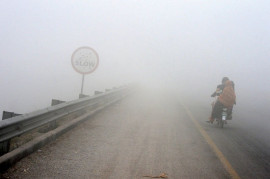
Die-hard eclipse junkies flew in from around the world to the Faroe Islands and Norway's Arctic Svalbard archipelago to observe the less than three minutes of daytime darkness, a phenomenon that has fascinated mankind since the beginning of time.
Europeans got their first glimpse through cloudy skies in Spain's Canary Islands in the early morning.
"We can see perfectly well the disc of the moon... It is one of the most marvellous astronomical spectacles you can see," Alfred Rosenberg, an astrophysicist at the Canaries Astrophysics Institute told AFP from the island of Tenerife.

A combo of 16 pictures taken on March 20, 2015 in Gaiberg near Heidelberg, southwestern Germany, shows a partial solar eclipse from the beginning (top, L) to the end (bottom, R). PHOTO: AFP
In the Swedish capital Stockholm a crescent-shaped sun shone through overcast skies as temperatures dropped, prompting people in the city's business district to stop and take pictures with their smartphones.
Eclipse enthusiasts were less lucky in Denmark's far-flung Faroe Islands.
"There are drifting clouds, and there is a large blue hole on the way. We've just had a quick sighting of the sun which is now almost half covered," Ole J Knudsen, an astrophysicist at Denmark's Aarhus University told AFP from the rainy Faroe Islands capital Torshavn.

A picture taken on March 20, 2015 shows a partial solar eclipse of the sun behind a cross on the Church of St Nicholay in Sofia. PHOTO: AFP
As with previous eclipses experts warned the public not to look directly at the sun due to the danger of eye damage.
Around 500 people gathered in London's Regent's Park under an overcast sky, hopeful of a glimpse of the partial eclipse as it moved across European skies before heading northwards via North Africa and the Middle East.
A police officer handed out special eclipse viewer glasses.

Ellis Knapton aged 6 views a partial solar eclipse at Bradgate Park in Newtown Linford, central England, March 20, 2015. PHOTO: REUTERS
Eight-year-old Rufus Aagaard had brought along a home-made viewer, fashioned out of a cardboard tube.
"It's made of cardboard, paper, Sellotape and tin foil, and a pinprick on the end," he told AFP.
More than 8,000 visitors gathered in the Faroes, where the total eclipse began at 9:41 am, and some 1,500 to 2,000 were expected in Svalbard, where it started at 11:11am.
A group of 50 Danes bought tickets aboard a Boeing 737 chartered by a science magazine to watch the event from the skies above the Faroe Islands.
While they will be shielded from the vagaries of Faroese weather, there are some things they won't get to experience when watching the eclipse from the sky.
"If you're on the ground you can hear the birds behaving differently, and the temperature falls," John Valentin Mikkelsen, a 63-year-old teacher from the Danish city of Aarhus told AFP.

A total solar eclipse can be seen in Svalbard, Longyearbyen, Norway, on March 20, 2015. PHOTO: AFP
In Svalbard, which is just emerging from four months of winter darkness, hotels have been fully-booked for years ahead of the event, the 10th solar eclipse of the 21st century.
In the Arctic archipelago, where everything is extreme, visitors must contend with temperatures as low as -20 Celsius at this time of year.
And then there's the threat of roaming polar bears.
A Czech tourist who was lightly injured in a polar bear attack on Thursday served as a reminder of the danger posed by the animals, which have killed five people since 1971 in Svalbard.

A partial solar eclipse of the sun is visible next to a pigeon at piazza del Duomo in Milan on March 20, 2015. PHOTO: AFP
Total eclipses occur when the moon moves between Earth and the Sun, and the three bodies align precisely.
The moon as seen from Earth is just broad enough to cover the solar face, creating a breath-taking silver halo in an indigo sky pocked by daytime stars.
Elsewhere, the eclipse was partial, to varying degrees: the sun was 97 percent hidden in Reykjavik, 93 percent in Edinburgh, 84 percent in London and 78 percent in Paris.
The next total solar eclipse visible from Europe is not due until August 12, 2026.

A partial solar eclipse of the sun is visible next to the statues of Milan's cathedral on March 20, 2015. PHOTO: AFP
Another celestial phenomenon is also expected on Friday.
Earth's satellite will appear as a "supermoon," which happens at its closest point to our planet, its perigee.
This, and the moon's alignment with the sun, will add to the gravitational pull on the seas - creating what is literally a high point in the 18-year lunar cycle.
The celestial ballet will on Saturday result in major tides most perceptible in Canada's Bay of Fundy, on the French Atlantic coast, in the English Channel and North Sea - but even the Mediterranean will feel the difference.
















1734778885-0/Untitled-(10)1734778885-0-270x192.webp)






COMMENTS (1)
Comments are moderated and generally will be posted if they are on-topic and not abusive.
For more information, please see our Comments FAQ